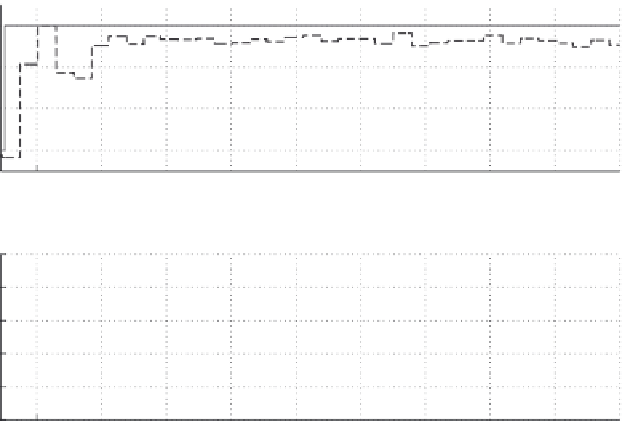Graphics Reference
In-Depth Information
Measured Input and Output of Rendering Process
400
390
380
Measured output
Reference
370
0.2
0.4
0.6
0.8
1
1.2
1.4
1.6
1.8
2
×10
5
Frame
×10
4
4.42
4.4
4.38
4.36
4.34
Input
4.32
0.2
0.4
0.6
0.8
1
1.2
1.4
1.6
1.8
2
×10
5
Frame
FIGURE 6.11
Reference tracking using fuzzy controller (to higher FPS).
frame rate with an approximate error of 5 FPS. The response for this action takes
approximately 4,000 frames—fewer than required by the previous control action.
However, in terms of tracking accuracy, the error can be observed as slightly
larger than the one shown in Figure 6.10. In both figures, some fluctuations of
input to the rendering process are observed. This can be explained by the scaling
computation used in the control framework and the resolution of the computer
program data structures.
In addition to comparing differences in controller designs, another objective of
using the ANFIS controller was to determine its robustness for handling variations
in user-defined references. Figure 6.12 depicts examples of such variations. Note
that the variations may span over an operating point or zone where the rendering
process may be approximated by a linear model. The ability of the ANFIS controller
to maintain the plant output close to the changing reference levels in such a scenario
indicates that it is inherently capable of controlling non-linear rendering processes.
6.6 DISCUSSION
Figure 6.11 indicates that the rendering process output tracks the user set reference
only after a short delay. This can be explained by the experiment set-up involving
network communication. Since the plant and controller communicate via a network
connection, transport delays arising when data are sent between the plant and the
controller are expected.
While such delays are minimised via an isolated network infrastructure, it should
be noted that data transport within computer systems is not instantaneous. Such




























Search WWH ::

Custom Search